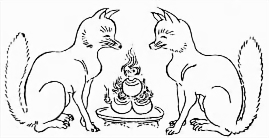June 30th is the mid-point of the year (yes, already) and Nagoshi-no-Harae (夏越之祓) in the Shinto calendar. This is one of two major purification rituals, the other being Toshikoshi-no-Ōharae (年越の大祓) on December 31st. This is an event where we purify ourselves of the kegare (a concept meaning pollution, bad energy, misfortune etc) that has accumulated within the past six months and to prepare ourselves for the next half of the year.
For those of us unable to attend a physical shrine, Shusse Inari of America will be holding an online ceremony at 7pm EST (12am on the 1st July in the UK). I will do my best to attend this, though the time difference does make it challenging. If you do attend, please make sure to leave a donation (Osaisen). All donations go towards their goal of building a physical Shinto shrine in Los Angeles.
There are also other ways we can observe Nagoshi-no-Harae in a more informal way. Here is a previous post I have written about some things you may do to celebrate it.
Purification in the Modern Day
Although they can seem rather archaic, I think that purification rites of any kind are still important and essential in modern times. It can only take a quick look at social media or the news to tank our mood and change our entire disposition for the day. It seems as if misfortune has no bias or restraint, striking again and again at the most vulnerable people in society. And not just humans are suffering – the environment and everything which lives in it is too.
Even if we do not fully believe in kegare and in purification, going through the steps to spiritually and physically cleanse ourselves is therapeutic and can put us in a better mindset to address our problems. We can see this when we clean up or declutter, it leaves a spacious feeling which in turn tends to lead to a more positive mood.
Taking Care of Your Heart
It may sometimes seem selfish to want to purify ourselves when so many others are suffering. But this is very important, it goes along the same lines as ‘putting your oxygen mask on before you can help others’. In Shinto, we can think of it as our inner self, our heart, visualised as a mirror that has become clouded and soiled – if we cannot see and reflect on ourselves and the kami with a clear and pure heart, we cannot possibly help others with sincerity and to the best of our ability. By purifying ourselves, we are making the first step towards helping others and the environment.
That is not to say that Shinto is a faith in which we go around trying to convert people, it is not at all. Instead we want to grow compassion and gratitude for all life and that includes other humans. So by regularly purifying ourselves, we can ensure that we are as kind and sincere as we can be, and that we drawn upon this when communicating with other people.
Kegare From Other People
Kegare often builds up from relationships with people, especially those who may be difficult, aggressive and genuinely hard to be with. If we have arguments or disagreements, we can feel the kegare – that negative energy buzz that pumps through us and remains in the room afterwards. We can’t always cut people away, especially if they are in our family or someone we have to work with. So we must try to be compassionate towards them and show them kindness even if we feel they do not deserve it. This is part of having an honest and pure heart, something that the kami encourage and something that is a core aspect of Shinto.
Of course there is a limit as with all things. If someone is constantly negative and draining towards you, please do not feel that you should endure this This person is not good for your or your mental or spiritual health. You can ask the kami about what to do, or take action to distance yourself from them.
There is no ‘good’ or ‘evil’ in Shinto, though this doesn’t mean that things in the news which seem harmful, scary and violent are any easier to accept. Although Shinto provides up with a rough guideline on morals and ethics it is ultimately down to us as individuals to make our own judgements. But we must try to consciously not give into hatred of others as it will only be reflected into us and make us more hateful. This internalized hate can then manifest as poor self-confidence, a hatred for our looks and other negative emotions.
These are just some of my own thoughts on kegare, especially relating to people. These are derived from texts I have read on Shinto, as well as my own experiences with the kami, especially Inari. Inari in particular seems to have a intolerance for those who cause harm, but they will never ask you to do anything which would put you in harm. Instead they usually encourage me to research more and to practice compassion for my enemies, so that I can not let them have power over me.
Shinto encourages us to try to be balanced and to practice gratitude and compassion. This can be very difficult and require a lot of self-reflection and processing. Don’t feel that you should dismiss your struggles, or those of others. It is not selfish to want to focus on yourself, even when the world is in turmoil and seems to demand your attention. The kami understand that humans suffer, as does all life. It is also quite easy to see the overlap with Buddhism here. Look after yourselves and only through that can you truly help others.


